Do you have a question about the Triumph Tiger XR and is the answer not in the manual?
Introduces the handbook and its importance for safe operation.
Explains the formatting of warnings, cautions, and notes in the manual.
Details the meaning and location of warning labels on the motorcycle.
Describes the intended off-road capabilities and limitations of the motorcycle.
Clarifies that LRH models have identical information to standard models unless stated otherwise.
Covers general safety information related to the motorcycle itself.
Details specific safety considerations for LRH models due to their altered suspension.
Warns about the hazards of petrol and exhaust fumes for safe operation.
Emphasizes the importance of wearing proper protective gear for rider safety.
Provides essential advice and warnings regarding safe riding practices.
Explains the importance of maintaining control using handlebars and footrests.
Details safe procedures for parking the motorcycle to prevent damage or accidents.
Advises on using only approved parts and accessories for safety and warranty.
Highlights safety considerations for maintenance and required equipment.
Shows the specific locations of warning labels on the motorcycle.
Identifies major components of the Tiger XR model.
Identifies major components of the Tiger XC model.
Identifies controls and components on the instrument panel and handlebars.
Explains how to find and record the Vehicle Identification Number (VIN).
Explains how to find and record the engine serial number.
Details the layout and function of the motorcycle's instrument panel with labelled components.
Explains the purpose and meaning of various warning and indicator lights.
Explains the function, activation, and adjustment of the cruise control system.
Describes the TC indicator light and its operation modes.
Details the procedure and conditions for activating cruise control.
Guides on increasing or decreasing the set speed while cruise control is active.
Explains the methods for deactivating cruise control.
Details the different positions and operation of the ignition switch and steering lock.
Describes the function of the engine immobiliser for security.
Identifies and explains the function of switches located on the right handlebar.
Explains the function of switches on the left handlebar, including lights and horn.
Describes the electronic throttle system and its operation.
Explains how to adjust the brake and clutch levers for comfort.
Explains the function and operation of the traction control system.
Explains how the TPMS system measures and transmits tyre pressure data.
Explains how to check the engine oil level using the sight glass.
Details the process for changing the engine oil and filter.
Provides warnings and cautions related to engine oil changes.
Covers cooling system checks and the type of coolant used.
Explains how to inspect and adjust the coolant level.
Emphasizes drive chain safety and the need for regular maintenance.
Explains chain lubrication and how to inspect for correct free movement.
Explains how to adjust the drive chain's vertical movement.
Explains how to inspect brake pads for wear and when to replace them.
Covers brake fluid properties, maintenance, and critical warnings.
Details how to check and adjust the front brake fluid level.
Details how to check and adjust the rear brake fluid level.
Details how to inspect front forks for damage, leaks, and smooth operation.
Explains compression damping adjustment for Tiger XC forks.
Provides charts for rear suspension preload and rebound damping settings.
Details how to adjust the spring preload on Tiger XR rear suspension.
Explains tyre markings and wheel types for Tiger XC and XR models.
Explains the impact of correct tyre inflation on stability and safety.
Advises on tyre wear and when to replace tyres based on tread depth.
Details safety precautions related to battery handling and potential hazards.
Explains the steps for safely removing the motorcycle battery.
Details battery charging procedures and safety warnings.
Details fuse box locations and how to identify blown fuses.
Shows fuse box layouts and protected circuits for XRT/XCA models.
Shows fuse box layouts and protected circuits for models other than XRT/XCA.
Covers headlight adjustment, visibility, and potential damage warnings.
Details how to adjust headlight beams vertically and horizontally.
Details the steps for preparing the motorcycle for long-term storage.
Outlines procedures for preparing the motorcycle after a period of storage.
Lists general dimensions, weights, and performance figures for models.
Provides detailed engine specifications for different models.
Details approved tyre sizes and recommended on-road pressures.
Specifies torque values for key components and recommended fluids.
Introduces the handbook and its importance for safe operation.
Explains the formatting of warnings, cautions, and notes in the manual.
Details the meaning and location of warning labels on the motorcycle.
Describes the intended off-road capabilities and limitations of the motorcycle.
Clarifies that LRH models have identical information to standard models unless stated otherwise.
Covers general safety information related to the motorcycle itself.
Details specific safety considerations for LRH models due to their altered suspension.
Warns about the hazards of petrol and exhaust fumes for safe operation.
Emphasizes the importance of wearing proper protective gear for rider safety.
Provides essential advice and warnings regarding safe riding practices.
Explains the importance of maintaining control using handlebars and footrests.
Details safe procedures for parking the motorcycle to prevent damage or accidents.
Advises on using only approved parts and accessories for safety and warranty.
Highlights safety considerations for maintenance and required equipment.
Shows the specific locations of warning labels on the motorcycle.
Identifies major components of the Tiger XR model.
Identifies major components of the Tiger XC model.
Identifies controls and components on the instrument panel and handlebars.
Explains how to find and record the Vehicle Identification Number (VIN).
Explains how to find and record the engine serial number.
Details the layout and function of the motorcycle's instrument panel with labelled components.
Explains the purpose and meaning of various warning and indicator lights.
Explains the function, activation, and adjustment of the cruise control system.
Describes the TC indicator light and its operation modes.
Details the procedure and conditions for activating cruise control.
Guides on increasing or decreasing the set speed while cruise control is active.
Explains the methods for deactivating cruise control.
Details the different positions and operation of the ignition switch and steering lock.
Describes the function of the engine immobiliser for security.
Identifies and explains the function of switches located on the right handlebar.
Explains the function of switches on the left handlebar, including lights and horn.
Describes the electronic throttle system and its operation.
Explains how to adjust the brake and clutch levers for comfort.
Explains the function and operation of the traction control system.
Explains how the TPMS system measures and transmits tyre pressure data.
Explains how to check the engine oil level using the sight glass.
Details the process for changing the engine oil and filter.
Provides warnings and cautions related to engine oil changes.
Covers cooling system checks and the type of coolant used.
Explains how to inspect and adjust the coolant level.
Emphasizes drive chain safety and the need for regular maintenance.
Explains chain lubrication and how to inspect for correct free movement.
Explains how to adjust the drive chain's vertical movement.
Explains how to inspect brake pads for wear and when to replace them.
Covers brake fluid properties, maintenance, and critical warnings.
Details how to check and adjust the front brake fluid level.
Details how to check and adjust the rear brake fluid level.
Details how to inspect front forks for damage, leaks, and smooth operation.
Explains compression damping adjustment for Tiger XC forks.
Provides charts for rear suspension preload and rebound damping settings.
Details how to adjust the spring preload on Tiger XR rear suspension.
Explains tyre markings and wheel types for Tiger XC and XR models.
Explains the impact of correct tyre inflation on stability and safety.
Advises on tyre wear and when to replace tyres based on tread depth.
Details safety precautions related to battery handling and potential hazards.
Explains the steps for safely removing the motorcycle battery.
Details battery charging procedures and safety warnings.
Details fuse box locations and how to identify blown fuses.
Shows fuse box layouts and protected circuits for XRT/XCA models.
Shows fuse box layouts and protected circuits for models other than XRT/XCA.
Covers headlight adjustment, visibility, and potential damage warnings.
Details how to adjust headlight beams vertically and horizontally.
Details the steps for preparing the motorcycle for long-term storage.
Outlines procedures for preparing the motorcycle after a period of storage.
Lists general dimensions, weights, and performance figures for models.
Provides detailed engine specifications for different models.
Details approved tyre sizes and recommended on-road pressures.
Specifies torque values for key components and recommended fluids.
| Engine Type | Liquid-cooled, 12 valve, DOHC, in-line 3-cylinder |
|---|---|
| Engine Capacity | 800 cc |
| Torque | 79 Nm @ 7, 850 rpm |
| Transmission | 6-speed |
| Wet Weight | 213 kg |
| Fuel System | Multipoint sequential electronic fuel injection |
| Power | 94 bhp (70 kW) @ 9, 250 rpm |
| Fuel Tank Capacity | 5.0 gallons (19 liters) |
| Front Suspension | Showa 43mm upside down forks |
| Rear Suspension | Showa monoshock with hydraulically adjustable preload |
| Rear Brakes | Single 255mm disc, Nissin single piston caliper |
| Front Brakes | Twin 308mm floating discs, Nissin 2-piston calipers |
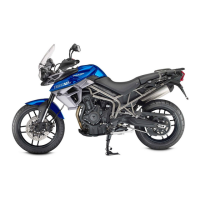
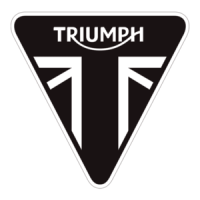


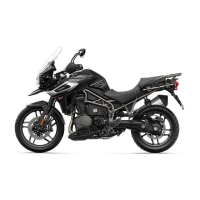


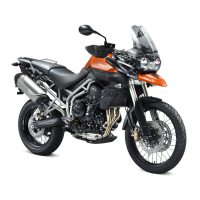
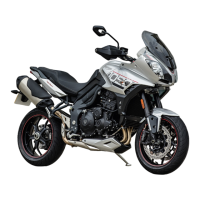
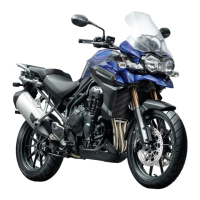
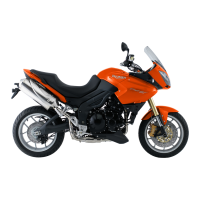
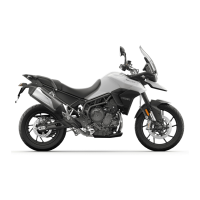
